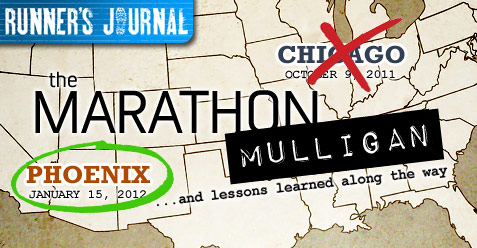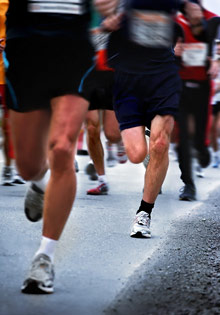Tokyo Marathon Preview: Too good to pass up

Do I really want to run two marathons in six weeks? Well, it certainly wasn’t my plan, but then I received an invitation to apply for the 2012 Tokyo Marathon press tour. At the top of the list of requirements for anyone accepted onto the tour was the following: “A reporter must actually run a full marathon in the 2012 Tokyo Marathon.” Hmm…time to make a decision.
I’d just recently signed up for the Arizona Rock ‘n’ Roll marathon when the Tokyo opportunity came about in December. I hadn’t planned on running another marathon so soon after competing in Chicago on October 9, but then I face-planted in the Windy City and chose Arizona on Jan. 15 as my redemption run. Two days after signing up, the Tokyo invitation landed in my inbox.
My training for Chicago began last February, so I already was a little nervous about how my legs would respond to another few months of training for Arizona. Did I really want to stretch it out to Feb. 26 now? My body said “no” but my mind said, “How the hell can you pass up a trip to Tokyo?!” Excellent point. My ego agreed, assuring me that I could handle running three full marathons – the first three I’ve ever run – in a four-month span. I wasn’t entirely confident but applied anyway, assuming my chances of actually being accepted were slim to none.
Then I got accepted. I hoped my ego wasn’t pulling my chain.
© TOKYO MARATHON
First things first, I needed to get through Arizona, preferably with a good time under my belt. Once I crossed that finish line in one piece, I shifted my focus to Tokyo. I was sore after Arizona, sorer than I’d ever been following a race, and it lingered for most of the next week. Of course, I didn’t have time to rest and recuperate. That comes in March. I put in a slow five miles on Sunday to loosen my legs up a bit, and then jumped back into my regular routine the following Tuesday, nine days after Arizona. My legs held up reasonably well at first, but my left knee got crankier as the miles began piling up throughout the week. Had I bitten off more than I could chew?
Maybe…but who cares? My training runs have been slower and a little more painful than usual this time around, so I know I won’t be in peak shape for Tokyo, but I don’t need to be. I just need to survive. This race is all about the experience, not my time, and I’m going to enjoy it. Besides, what’s the point of all this training if you don’t really challenge yourself every so often?
I arrive in Tokyo on Feb. 23 with just enough time to grab some dinner before hopefully getting a full night’s sleep in my room at the Keio Plaza Hotel. I plan on exploring the city Friday before my briefing with members of the Tokyo Marathon Foundation at 4:00, where I assume I’ll meet the other writers/runners on the press tour and get all the info I’ll need for the weekend. Saturday morning, I’m participating in the International Friendship Run, a casual 1.25-mile fun run dubbed as an intercultural event to help overseas runners meet other runners from all over the world. Should be a great primer for the race. Then it’s off to the expo at Tokyo Big Sight in Ariake to pick up my race packet before eating a huge carb-filled dinner and crawling into bed early Saturday night.
 The race begins a little later than I’m used to Sunday morning, but I’m most definitely not complaining about the 9:10 start if it affords me an extra hour or two of sleep. Once we’re off, I won’t be obsessing about my watch, but instead will be soaking in the moment and enjoying the surroundings, high-fiving spectators and snapping some pictures along the way. The Tokyo Tower (right), the Asakusa Kaminarimon Gate and the Nijubashi Bridge outside of the Imperial Palace are just a few of the sights topping my list of likely photo opps around the course.
The race begins a little later than I’m used to Sunday morning, but I’m most definitely not complaining about the 9:10 start if it affords me an extra hour or two of sleep. Once we’re off, I won’t be obsessing about my watch, but instead will be soaking in the moment and enjoying the surroundings, high-fiving spectators and snapping some pictures along the way. The Tokyo Tower (right), the Asakusa Kaminarimon Gate and the Nijubashi Bridge outside of the Imperial Palace are just a few of the sights topping my list of likely photo opps around the course.
Once the race is over, I’ll have roughly 24 hours to recover and take in as much of Tokyo as I can before boarding my 3:30 flight back to the States Monday afternoon. To say that I’m a little concerned about how my legs will feel on the 14-hour flight to Atlanta would be an understatement, but the fantastic sports massage I got from Kim at Nature’s Touch Massage and Wellness Center should help in that regard. Last year, Kim alleviated knee pain that neither my sports doctor nor my physical therapist could diagnose during three months of appointments and therapy sessions, and she worked her magic again earlier this week. If you’re a runner who’s never had a sports massage, you’re really missing out.
No matter how the race goes or how I feel on the flight home, this is going to be one heck of an experience. To best capture the spirit of the weekend, I’ll be launching my Tokyo Marathon Live Blog on Friday Feb. 24 and updating it in the days leading up to and following the race, so be sure to follow along. But I can’t get ahead of myself just yet. My body may be worn out from 12 months of marathon training, but I still have two weeks to go before I board that plane on Feb. 22. No rest for the weary runner.
You can follow us on Twitter and Facebook for content updates. Also, sign up for our email list for weekly updates and check us out on Google+ as well.



 When I cross the finish line in Phoenix Sunday morning (hopefully in 3:30 or faster), I will have finished two marathons within three months of each other. It’s a bit unbelievable considering how intimidating the thought of running 26.2 miles seemed to me at this time last year, but things get even crazier.
When I cross the finish line in Phoenix Sunday morning (hopefully in 3:30 or faster), I will have finished two marathons within three months of each other. It’s a bit unbelievable considering how intimidating the thought of running 26.2 miles seemed to me at this time last year, but things get even crazier.










